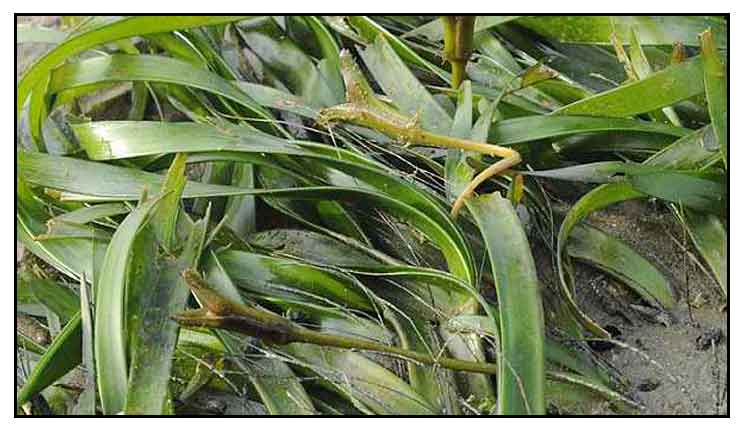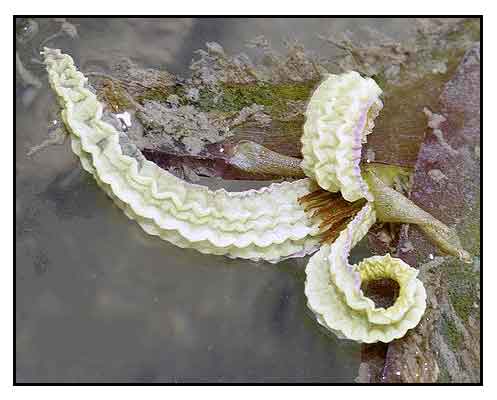
Botanical snippet
- Seagrasses are marine flowering plants that play important roles in marine ecosystems, i.e., reducing wave energy, stabilizing sand, and providing shelter for a variety of marine animals. (16)
Botany
Lamon is an aquatic weed. Leaves are long and ribbon-like, alternating in two ranks. Roots are cordlike with firm black fibers anchored in the bottom mud. Fruits occur singly, connected by spiral stalks to the base of old leaves. Flowers are water pollinated (hydrophilous). Female stalk lengthens before pollination and fertilization. After fertilization, the stalk shortens and coils in a springlike fashion until maturity, and straightening out when the seed are ready for release.
Distribution
- Found in muddy salt-water gulfs, lagoons, and seagrass areas of the Philippines and other tropical seas.
-
in fishponds, waterways, and sea bathing resorts, sometimes colonizing in abundance to cause obstruction of water flow.
- Widespread in the Indo-Pacific, from southern Japan to Taiwan, Indonesia, and Malaysia, extending to China, Vietnam, and Thailand.
 Constituents Constituents
- Study for calorific content showed 68.82 K cal g, the highest in the species tested. Leaves and rhizomes also yielded high content of phenols. (3)
- Study yielded eleven pure compounds including four flavonoids and five steroids. (See study below) (3)
- Study of proximate composition of seeds showed protein 8.8%, lipid 0.2%, carbohydrate 72.4%, ash 6.4%, kCal 3.27.
- In a comparative study of seagrasses, E. acoroides had the lowest insoluble fiber content. Its percentage of soluble fiber against total fibers was 62.4%.
-
Rhizomes and roots have yielded . luteolin, apigenin, luteolin 4’-glucuronide, luteolin 3’-glucuronide, stigmasta-4,22-dien-6β-ol-3-one, stigmasta-4,22-dien-3,6-dione, stigmast-22-en-3-one, stigmasta-5,22-dien-3-O-β-D-glucopyranoside, daucosterol, hexacosyl alcohol, p-hydroxy-benzaldehyde, n-hexadecanoic acid. Fresh leave are rich in sterol and fatty acid components, sitosterol, stigmasterol, palmitic acid, linoleic acid, linolenic acid, and stigmasterol derivatives. (13)
- Study of aqueous extract yielded twelve types of major chemical constituents: six flavonoids, two homocyclic peptides, two long chain aliphatic amides, one tannin and one nitrogen heterocyclic compound. (see study below) (15)
- Phytochemical screening of methanol extract yielded alkaloids, flavonoids, saponins, phenols, tannins, and steroids. Proximate analysis yielded 9,35% crude protein, 0.07% crude lipid, 54.94% carbohydrate and 31.98% ash. (17)
Properties
- Seeds considered to have aphrodisiac and contraceptive properties.
-
Studies suggest antimicrobial, antioxidant, antilarval, anticancer properties.
Parts used
Rhizome, seed.
Uses
Edibility / Nutrition
- Study showed the seagrass to be high in kilocalorie content, with high content of phenols in the leaves and rhizomes, suggesting a potential for feed/food.
- Flour made from Enhalus used in the preparation of Chocolate Chip Cookies. (See Seagrass recipe I)
(8)
- In the Philippines, seeds are traditionally eaten. Raw seeds described as crunchy and sweet; boiled seeds taste like cooked sweet potato or chestnuts. (13)
Folkloric
- In traditional medicine, rhizome used for muscle pains, skin diseases, wounds, and stomach problems. Used as remedy for stings of different kinds of rays and scorpions. Also used as tranquilizer for babies. (13)
- In India, skin of fresh rhizome is peeled and taken with a cup of sea-water for heart disease and low blood pressure.
(6) Used for treatment of heart conditions and sea sickness. (13)
- In Thailand, used carminative and to improve blood and lymph circulation. (13)
Others
- Biomass: A study in Sabah, Malaysia showed seagrass Enhalus acoroides produced very high biomass especially in the muddy habitat bordering mangroves (e.g. total biomass of 468.5 g AFDWm.2).(7)
Studies
• Antimicrobial / Anticancer: Study evaluated the leaf extracts of E. acoroides for antimicrobial and anticancer properties. Results showed the ethyl acetate extracts inhibited the growth of all the tested bacteria. On cytotoxicity testing, it killed 50% of HeLa ells.(2)
• Nutritional Value: Study evaluated the biochemical and calorific content of different species of seagrasses. Enhalus acoroides yielded 68.82 K cal g, the highest in the species tested. E. acoroides also yielded maximum values in leaf and rhizomes. The calorific contents of the seagrasses were equivalent to Bengal gram, peas, potato, and sweet potatoes. Results suggest seagrasses could be considered feed/food.(3)
• Antifeedant / Antibacterial / Antilarval: Study yielded eleven pure compounds including four flavonoids and five steroids. Three flavonoids were antifeedant against second-instar larvae of Spodoptera litura. Two flavonoids have antibacterial activity against several marine bacteria. One flavonoids showed strong antilarval activity against Bugula neritina larvae. (4)
• Biomass Reduction from Solar Radiation and Tidal Exposure: Monitoring over eleven years revealed a declining trend in above-ground biomass (54% significant reduction from 2000 to 2010) which negatively correlated with tidal exposure and solar radiation. Enhalus acoroides contributes to the canopy habitat that provides for diverse, endangered, and economically important fauna throughout the Indo-Pacific bio-region. (5)
• Antioxidant: Study of leaf sample yielded high levels of phenolic and proanthocyanidins when compared to root and rhizome. The leaf samples exhibited higher total antioxidant activity (11.770±0.026 mg Ascorbic acid equivalents/g), higher percentage of DPPH radical scavenging activity (25.76±0.04) and higher reducing power (18.060±0.73) in terms of mg GAE/g. There was significant correlation between the phenolic and proanthocyanidin content with the antioxidant activity. (9)
• Antioxidant / Fiber Content: Study evacuated four tropical seagrasses from Indonesia. An methanol extract of E. acoroides showed high activity on scavenging DPPH radicals. It also showed the highest content of soluble fiber.(10)
• Toxicological / Histopathological / Biochemical Evaluation: Acute toxicity i.e., LD50 was more than 3000 mg/kg in Wistar albino rats. Sub-acute toxicity 28day repeated dose) showed NOAEL (no observed adverse effect level) at dose of 400 mg/kg in Wistar albino rats. There were no significant differences in hematological, biochemical, and histopathological parameters. Results suggest a high margin of safety. (14)
• Anti-Algal / Luteolin-7-O-Glucuronide / Inhibition of Phaeocystis globosa: Phaeocystis globosa is a harmful algae species. Study evaluated aquatic plants to inhibit harmful algal blooms (HABs). E, acoroides aqueous extract could significantly inhibit the growth of P. globosa, decrease the chlorophyll-a content and photosynthetic efficiency. Study yielded twelve types of major chemical constituents Luteolin 7-O-glucuronide was one of the antialgal compounds of E. acoroides aqueous extract with potential as novel algaecide. (15)
• Antimicrobial Activity of Endophytic Fungi Isolated from E. acoroides: Endophytic fungi were isolated from seagrass Enhalus acoroides. Forty0seven endophytic isolates were classified into 17 phylogenetically diverse genera. Crude extracts including culture media and cells of all isolates were tested for anitmicrobial activities against 10 potential human pathogens. Extracts from 10 isolates (80.85%) showed antimicrobial activity with MIC values ranging from 4 to 200 µg/mL. Results suggest endophytic fungi from seagrasses such as E. acoroides has potential as a good source of natural antimicrobial products. (16)
• α-Glucosidase Inhibitory Activity: Study evaluated the α-glucosidase inhibitory activity of three species of seagrasses viz., Enhalus acoroides, Thalassia hemprichii and Cymodocea rotundata. Extracts of all parts i.e., root, leaf, and stem were prepared with maceration using 80% ethanol solvents. Results showed the 80% ethanol extract of Enhalus acoroides showed highest α-glucosidase inhibitory activity with IC50 168.15 ± 2.71 µg/mL. Kinetic type of inhibition was non-competitive. Phytochemical screening yielded phenols, flavonoids, terpenes, and tannins, with total phenolic content of 28.76 ± 2.46 mgGAE/g, (18)
Availability
Wild-crafted.
|

![]()





